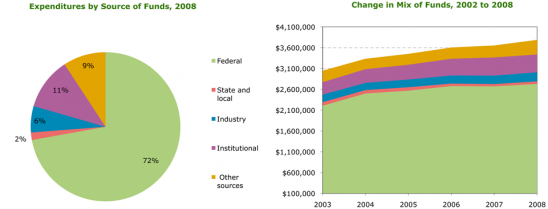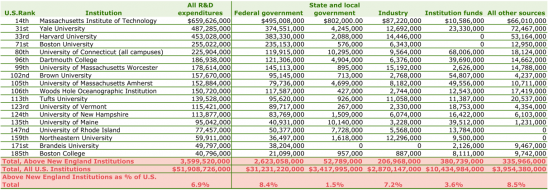- New England universities performed more than $3.7 billion worth of research and development in 2008, but the region’s share has dropped to 7.3% of the U.S. total, down from more than 10% in the 1980s. Had the region’s share stayed at 10%, an additional $1.5 billion would have been spent in New England university labs in 2008 alone.
- New England university research labs have been world-famous for ideas that breed companies and whole industries in fields from biotechnology to photonics.
- New England universities capture a disproportionate share of research dollars in fields such as environmental sciences. But the region is overly reliant on federal research funds and underfunded by the New England states.
Fig. 60: Research and Development Expenditures at New England’s Universities and Colleges and New England’s Share of U.S. R&D Expenditures, 2001 to 2008
Click on the chart to view it full size in a new window.
Fig. 61: Regional Comparison of Research and Development Expenditures at Universities and Colleges, 2003 and 2008
Click on the chart to view it full size in a new window.
Source: New England Board of Higher Education analysis of National Science Foundation data.
Fig. 62: Research and Development Expenditures at New England Universities and Colleges by Field, 2008
Click on the chart to view it full size in a new window.
Source: New England Board of Higher Education analysis of National Science Foundation data.
Fig. 63: Research and Development Expenditures at New England Universities and Colleges by Source of Funds, 2003 to 2008
Click on the chart to view it full size in a new window.
Source: New England Board of Higher Education analysis of National Science Foundation data.
Fig. 64: Research and Development Expenditures at New England Colleges and Universities by U.S. Rank and Source of Funds, 2008
Click on the chart to view it full size in a new window.
Source: New England Board of Higher Education analysis of National Science Foundation data.
[ssba]





